Mushroom cultivation is the art of growing mushrooms in controlled environments for optimal quality and growth. It involves creating the perfect conditions for these fungi to thrive and produce their fruiting bodies, which we commonly refer to as mushrooms. Mushrooms play a crucial role in various cuisines worldwide due to their distinct flavors and textures.
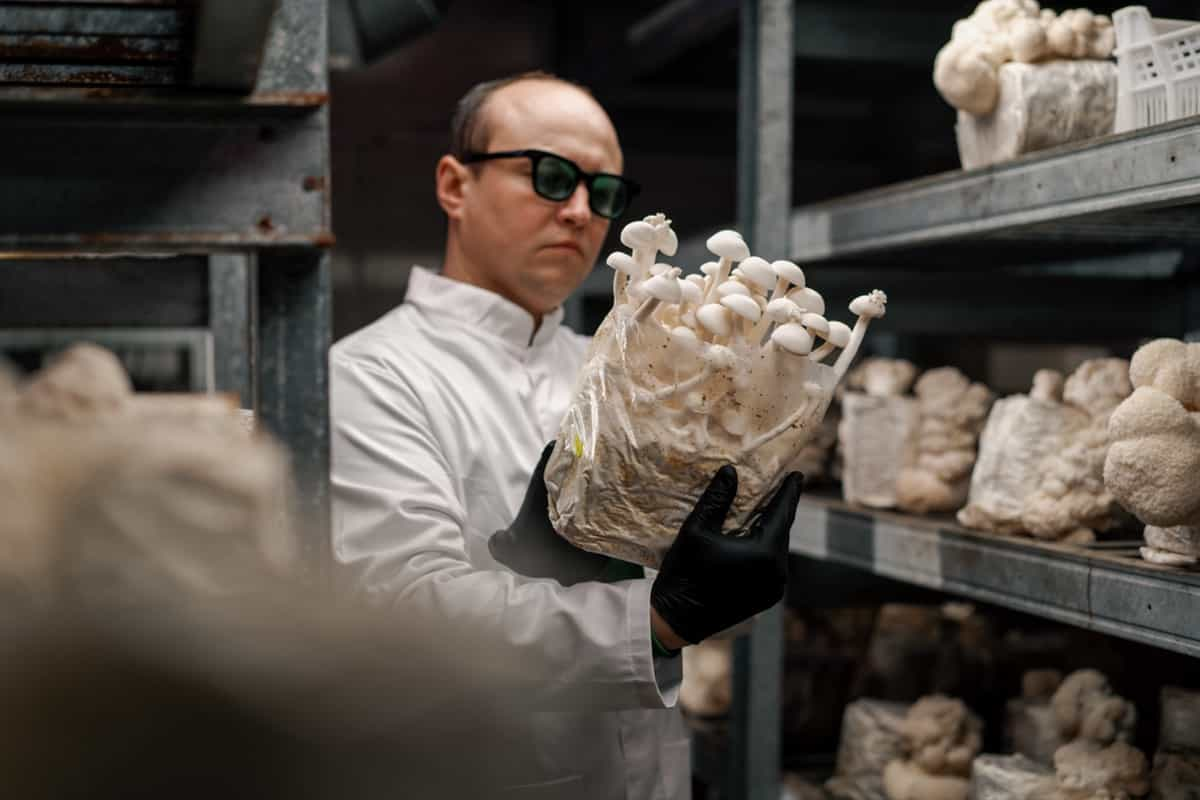
Types of Mushrooms for Cultivation
When it comes to mushroom cultivation, there is a wide array of mushroom types that can be grown. Each type has its unique characteristics and requirements for successful cultivation. The popular choice for beginners is the oyster mushroom, known for its fast growth rate and versatility in different growing conditions. Another common option is the shiitake mushroom, prized for its rich flavor and medicinal properties.
For those looking to add a gourmet touch to their dishes, the morel mushroom is a sought-after delicacy with a distinctive nutty flavor. Another popular variety is the White Button Mushroom, known for its mild taste and versatility in various dishes. Some other varieties of mushrooms are Portobello Mushroom, Chanterelle Mushroom, Enoki Mushroom, Lion’s Mane Mushroom, Maitake Mushroom, and King Oyster Mushroom.
Understanding Mushroom Biology
Mushrooms belong to the fungi kingdom, distinct from plants and animals. They reproduce through spores rather than seeds, making their life cycle unique. Mushrooms require specific environmental conditions to grow, including moisture, temperature, and substrate composition. The mycelium, a network of thread-like structures, is the vegetative part of the fungus responsible for nutrient absorption.
In case you missed it: How to Control Pests and Diseases in Mushrooms: Best Way to Manage with Natural and Organic Remedies
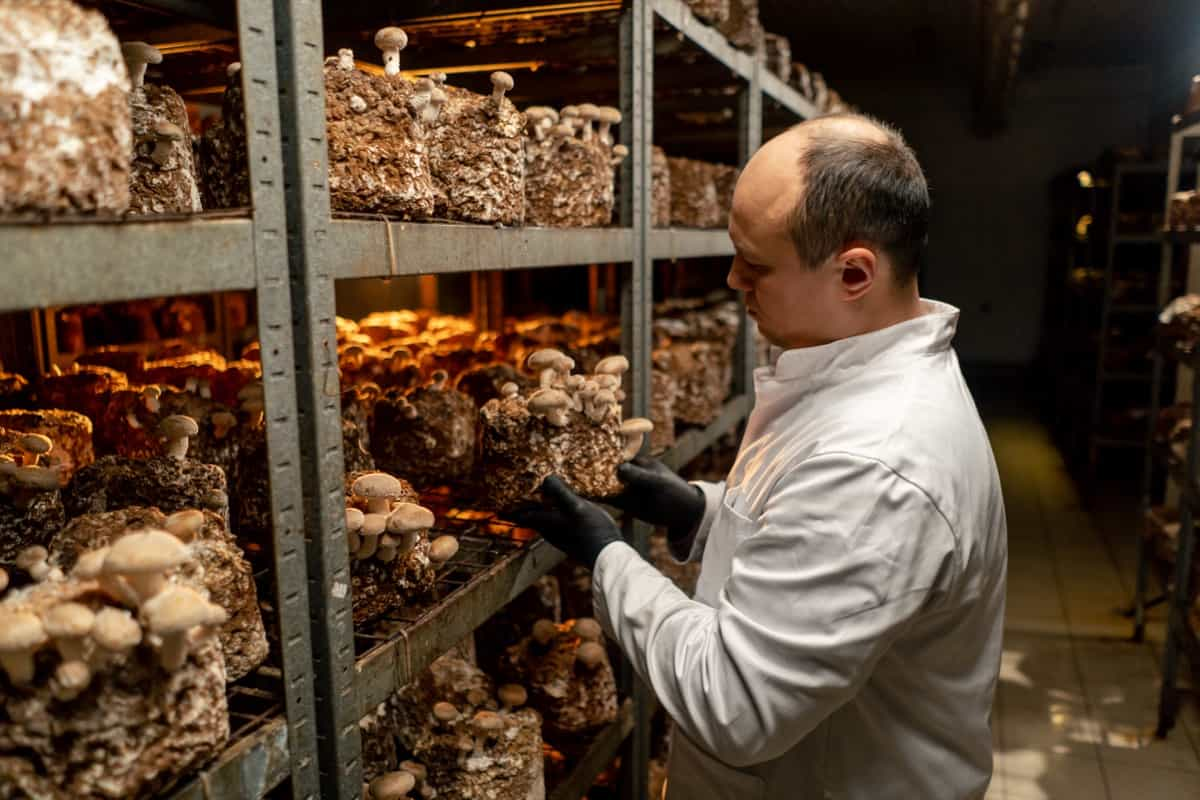
It colonizes substrates before forming fruiting bodies we recognize as mushrooms. Different mushroom species have varying growth requirements and preferences. Mushroom biology encompasses complex processes like fruiting body formation and spore dispersal. Understanding these stages helps growers optimize cultivation conditions for maximum yield.
Setting Up the Cultivation Area
Select a well-ventilated location with controlled temperature and humidity levels. Make sure the area is free from contaminants that could harm the mushroom growth. Next, prepare your workstations and tools in advance. Have all necessary supplies, such as substrate materials, spawn, and containers, ready to go. Designate specific areas for each stage of the cultivation process to maintain efficiency.
Ensure proper lighting conditions are met by either using natural light or installing artificial grow lights if needed. Proper air circulation is also key to preventing mold or other issues that may arise in stagnant environments. Keep your cultivation area consistently clean and sanitized throughout the entire process to promote healthy mushroom growth.
Substrates for Mushroom Growth
Substrates are essentially the materials from which mushrooms grow and derive their nutrients. Common substrates include straw, wood chips, sawdust, and even coffee grounds. Each type of mushroom has its preferred substrate based on its nutritional requirements. For example, oyster mushrooms thrive on a mix of hardwood sawdust and wheat bran, while shiitake mushrooms prefer oak logs or supplemented sawdust blocks.
The substrate provides essential nutrients for mycelium colonization and subsequent fruiting body formation. Proper moisture content and pH levels in the substrate are key factors that influence mushroom growth. Experimenting with different substrates can help you understand which works best for your chosen mushroom species.
Inoculation and Spawn Preparation
It involves introducing the mushroom mycelium to a suitable substrate for growth. The spawn acts as the seed that kickstarts the growth of mushrooms. To prepare the spawn, you can use various methods, such as grain spawn or sawdust spawn. These act as carriers for the mycelium to colonize before transferring it to the final growing medium.
In case you missed it: How to Grow Cordyceps Mushrooms: Profitable Cultivation Practices and Cordyceps Mushroom Price
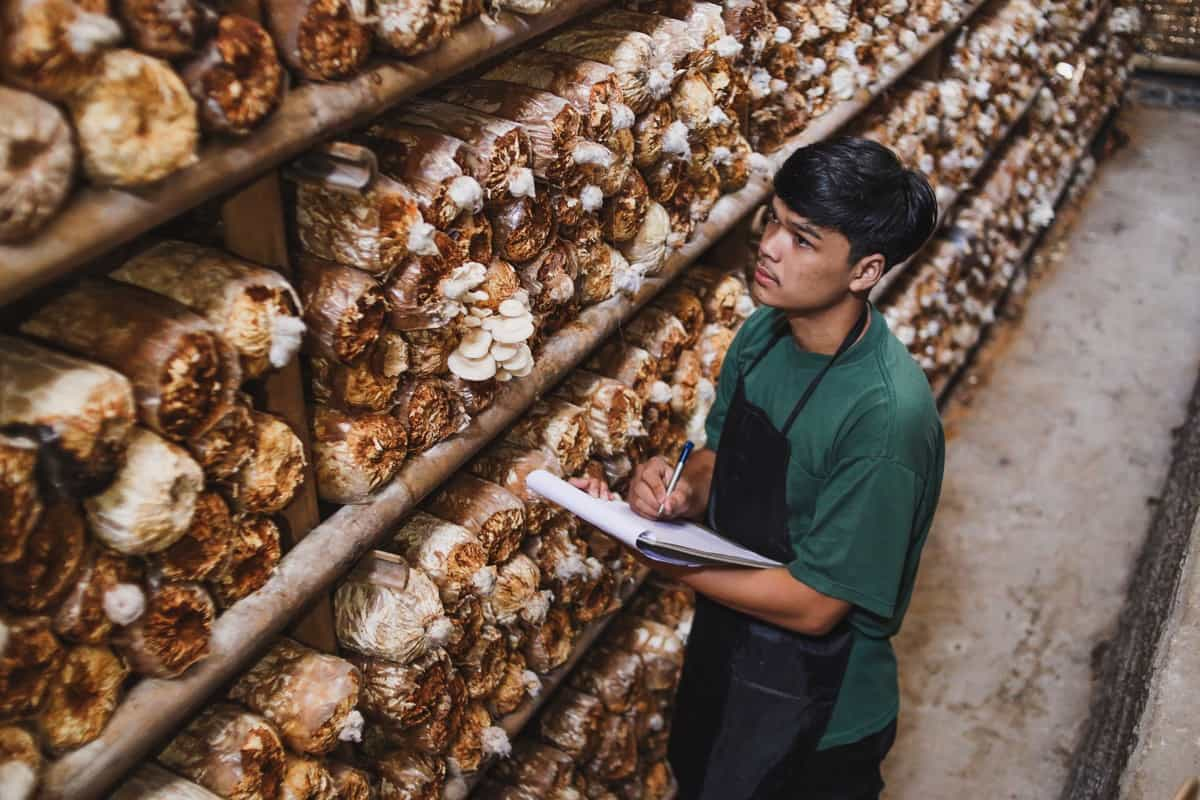
The inoculation process requires sterile conditions to prevent contamination from other microorganisms. This can be done in a clean and controlled environment using proper sterilization techniques. Once inoculated, it’s important to monitor the colonization progress of the mycelium within the substrate. This stage sets the foundation for healthy mushroom development and eventual fruiting.
Incubation Conditions and Parameters
During the incubation stage, maintaining optimal conditions and parameters is key to fostering mycelium development within the substrate. The temperature plays a major role during the incubation period, typically ranging between 21-23°C for most mushroom varieties. Humidity levels should be kept high to prevent drying out of the substrate and promote mycelial growth.
Proper air exchange is essential to provide fresh oxygen while removing carbon dioxide produced by the growing mycelium. This helps prevent contamination and ensures healthy mushroom formation. Light exposure should be minimal during this phase, as mushrooms thrive in darkness during their early stages of development. A consistent environment free from fluctuations in temperature, humidity, and light will support strong mycelial growth leading up to fruiting.
Controlling Environmental Factors
Maintaining the right temperature, humidity levels, and air circulation can significantly impact the success of your mushroom farm. Temperature plays a vital role in mushroom growth, with different species requiring specific ranges for development. Humidity levels must also be carefully monitored to prevent drying out or excessive moisture, which could lead to contamination issues.
In case you missed it: Mushroom Farming Business Plan: Investment, Profit, and Cultivation Steps
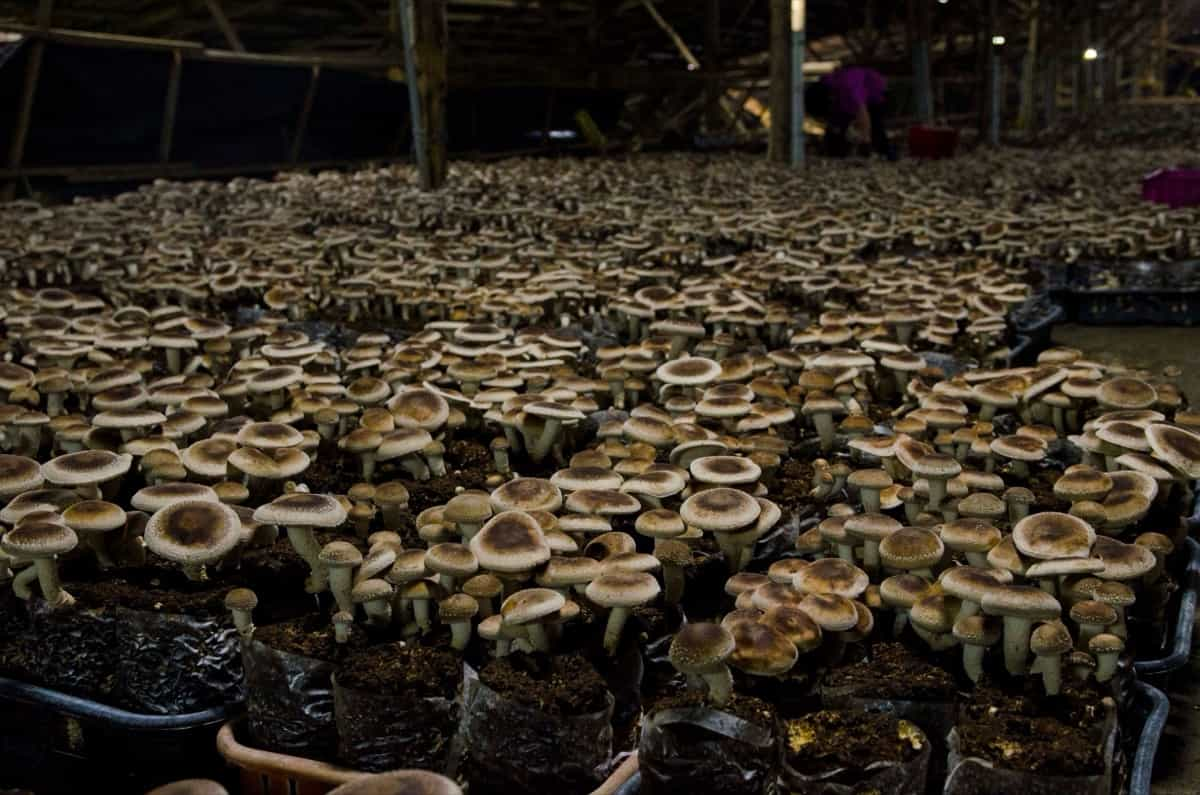
Proper ventilation is important to provide fresh air and remove carbon dioxide produced during respiration. This helps prevent the harmful gases that can hinder mushroom growth. Light exposure should be controlled as mushrooms prefer darkness for fruiting. Using blackout curtains or maintaining a consistent light schedule can help regulate this factor effectively.
Mushroom Growth Phases
There are four stages to the life cycle of a mushroom: Spore germination, colonization, fruiting, and sporulation.
Spore Germination: The mushroom life cycle begins with the germination of mushroom spores. Spores are the reproductive units of fungi, similar to seeds in plants. When conditions are favorable, spores germinate, and a single spore develops into a structure called a hypha, which is a single filament of fungal cells.
Colonization (Spawn Run): During this stage, the hyphae grow and branch out, forming a network called mycelium. The mycelium colonizes the substrate, which is the material on which the mushroom grows. This phase is also known as the spawn run when mushroom spawn, which is essentially mycelium grown on a nutrient-rich substrate, is introduced to the main substrate to facilitate colonization.
Fruiting: Once the the mycelium and environmental conditions are fully colonized substrate are favorable, the mushroom enters the fruiting stage. This is when primordia, or tiny mushroom pins, begin to form on the surface of the substrate. These primordia develop into mature mushrooms, which emerge from the substrate and grow to full size.
Sporulation: The final stage of the mushroom life cycle is sporulation, where mature mushrooms release spores into the environment. Spores are typically released from the gills or pores of the mushroom cap. Spores are dispersed by various means, such as air currents, animals, or water, allowing the fungus to reproduce and continue its life cycle.
Harvesting Techniques
Harvesting techniques play a crucial role in mushroom cultivation, as they determine the quality and yield of your crop. When it comes to harvesting mushrooms, timing is key. Harvesting too early can result in underdeveloped mushrooms while waiting too long can lead to over-matured ones. To harvest mushrooms properly, gently twist or cut them at the stem base using a sharp knife.
In case you missed it: How this Farmer Earning 60 Thousand Rupees from Milky Mushroom Farm at Home
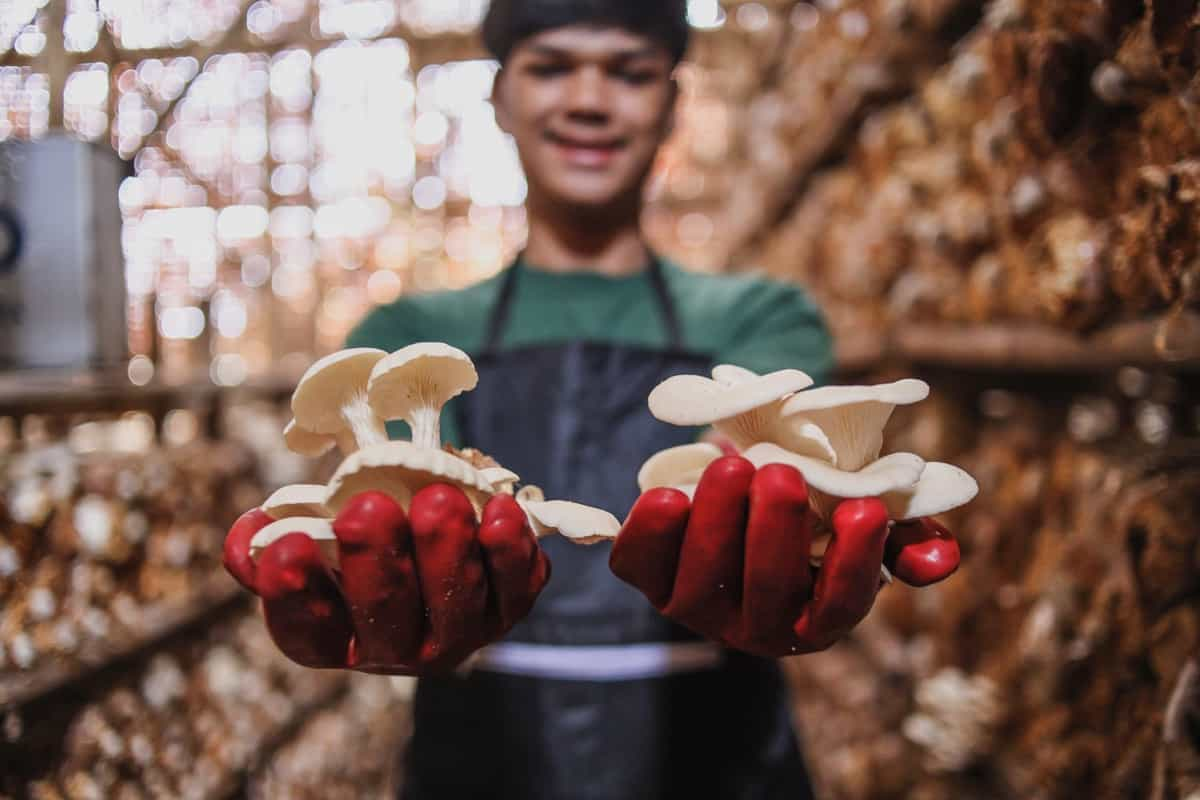
Be careful not to damage the surrounding mycelium or disturb other mushrooms in the process. Always handle harvested mushrooms with care to avoid bruising or damaging their delicate structure. It’s essential to monitor your crop for mature specimens ready for harvesting regularly. By picking them at their peak freshness and size, you ensure maximum flavor and nutritional value for consumption or sale.
Post-Harvest Handling and Storage
After successfully harvesting your mushrooms, the next crucial step is post-harvest handling and storage. This phase is essential to maintain the quality and freshness of your produce for longer periods. Proper handling methods can make a difference in the shelf life of your mushrooms. Once harvested, it’s important to gently clean any dirt or debris off the mushrooms using a soft brush or cloth.
Avoid washing them with water, as this can lead to spoilage. Trim any damaged or discolored parts before storing them to prevent contamination. For short-term mushroom storage, place the mushrooms in a paper bag or breathable container in the refrigerator. Make sure not to overcrowd them to allow proper air circulation. For long-term storage, consider drying or freezing the mushrooms for later use in recipes.
Pest and Disease Management
Pest and disease management in mushroom cultivation is crucial to ensure a healthy crop. Pests like mites, flies, and nematodes can wreak havoc on your mushrooms if left unchecked. Keeping a clean cultivation area and monitoring for any signs of infestation is key. Implementing preventive ways such as proper sanitation practices, using pest-resistant substrates, and maintaining optimal environmental conditions can help reduce pest and disease outbreaks.
Regularly inspecting your mushrooms for any abnormalities or unusual growth patterns can also aid in early detection. If pests or diseases are identified, immediate action is necessary to prevent further spread. Utilizing natural remedies or organic pesticides can be effective in controlling pests without compromising the quality of your mushrooms.
Quality Control and Safety Measures
It is crucial to produce high-quality produce while prioritizing the well-being of both consumers and workers. Implementing strict protocols for cleanliness, hygiene, and pest management helps prevent contamination during the growing process. Regular inspections of the cultivation area also help identify any potential issues early on. Proper training of staff members on handling mushrooms, as well as maintaining equipment properly sanitized, are key aspects of quality control.
By monitoring temperature and humidity levels consistently, growers can create an optimal environment while minimizing risks associated with pathogens or mold development. Adhering to food safety regulations and standards is essential to guaranteeing that the harvested mushrooms meet industry requirements. This includes proper packaging, labeling, and storage practices to maintain freshness and extend shelf life. Regular testing for contaminants ensures that only safe-to-consume mushrooms reach customers’ tables.
Marketing and Selling Mushrooms
There are various avenues you can explore to reach potential buyers to marketing and selling mushrooms. The effective strategy is establishing partnerships with local restaurants or grocery stores that value fresh, locally sourced produce. Networking within the culinary community can open up opportunities for your mushroom business to thrive. Utilizing social media can help showcase your products visually and attract a wider audience.
In case you missed it: How to Grow Mushrooms in Coffee Grounds at Home: Steps, Ideas, and Tips for Beginners
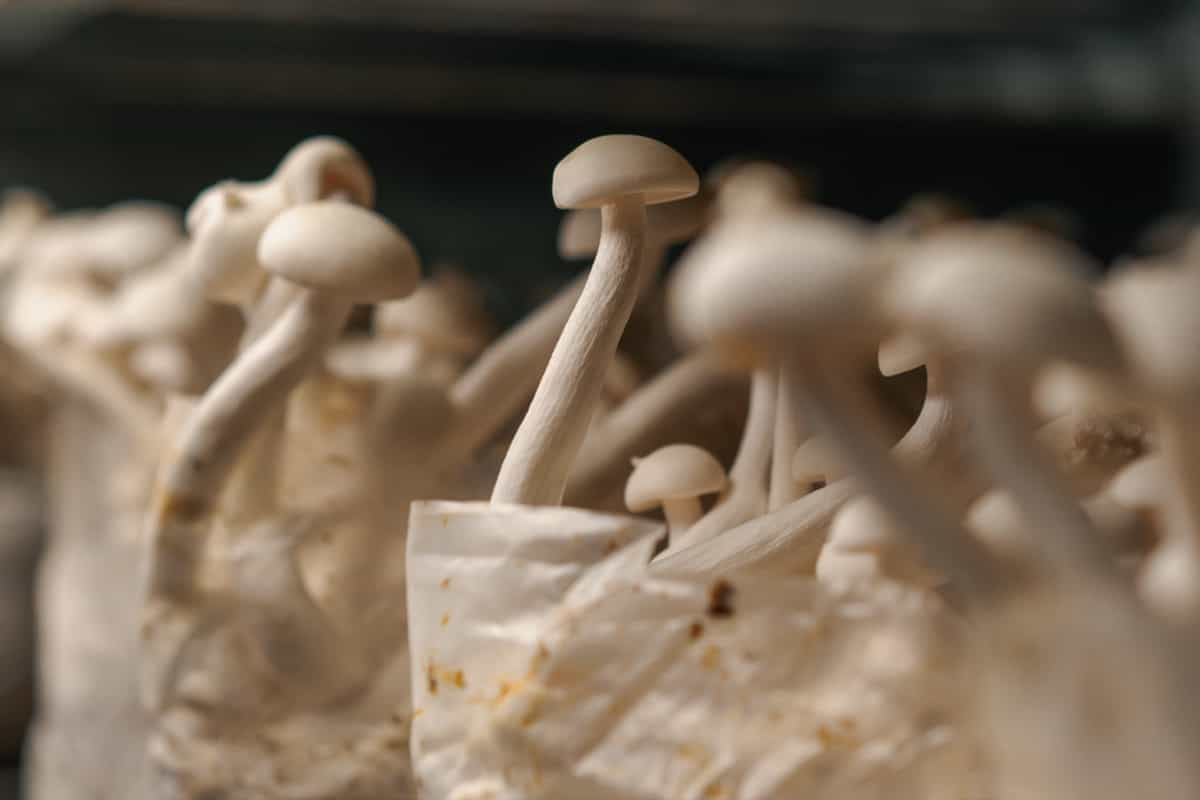
Engaging with customers through interactive posts, behind-the-scenes glimpses of your cultivation process, and recipe ideas can create buzz around your brand. Attending farmers’ markets or setting up a roadside stand can also be a great way to connect with consumers for high-quality mushrooms directly. Offering samples and sharing information about the health benefits of different mushroom varieties can pique interest and drive sales.
Exploring online marketplaces such as Etsy or specialty food websites can expand your reach beyond local markets. Creating an e-commerce website for your mushroom products allows customers to place orders for their homes conveniently. Collaborating with chefs for special events or participating in food festivals can generate excitement around your mushrooms and introduce them to new audiences.
Advanced Techniques in Mushroom Cultivation
The main technique is utilizing controlled-environment systems, such as climate-controlled rooms or greenhouses. These environments allow for precise regulation of temperature, humidity, and light to optimize mushroom growth. Another advanced method involves genetic selection and breeding of mushroom strains for desired traits like higher yields or resistance to diseases. This process requires expertise but can lead to significant improvements in your crop production.
Exploring innovative substrate formulations, such as incorporating supplements like coffee grounds or sawdust, can enhance the nutritional value of mushrooms and promote healthier growth. Additionally, adopting automated monitoring and irrigation systems can streamline the cultivation process by ensuring optimal growing conditions are consistently maintained.
Sustainability and Eco-Friendly Practices in Mushroom Farming
By utilizing agricultural waste products like straw, sawdust, or even coffee grounds as the substrate for mushroom growth, farmers can reduce waste and create a valuable product. Furthermore, mushrooms are known to have a low carbon footprint due to their effective use of resources. They require minimal water and land to grow, making them environmentally friendly for food production.
In case you missed it: Top 22 Steps/Ways to Boost Mushroom Yield: How to Increase Production, Quality, and Size
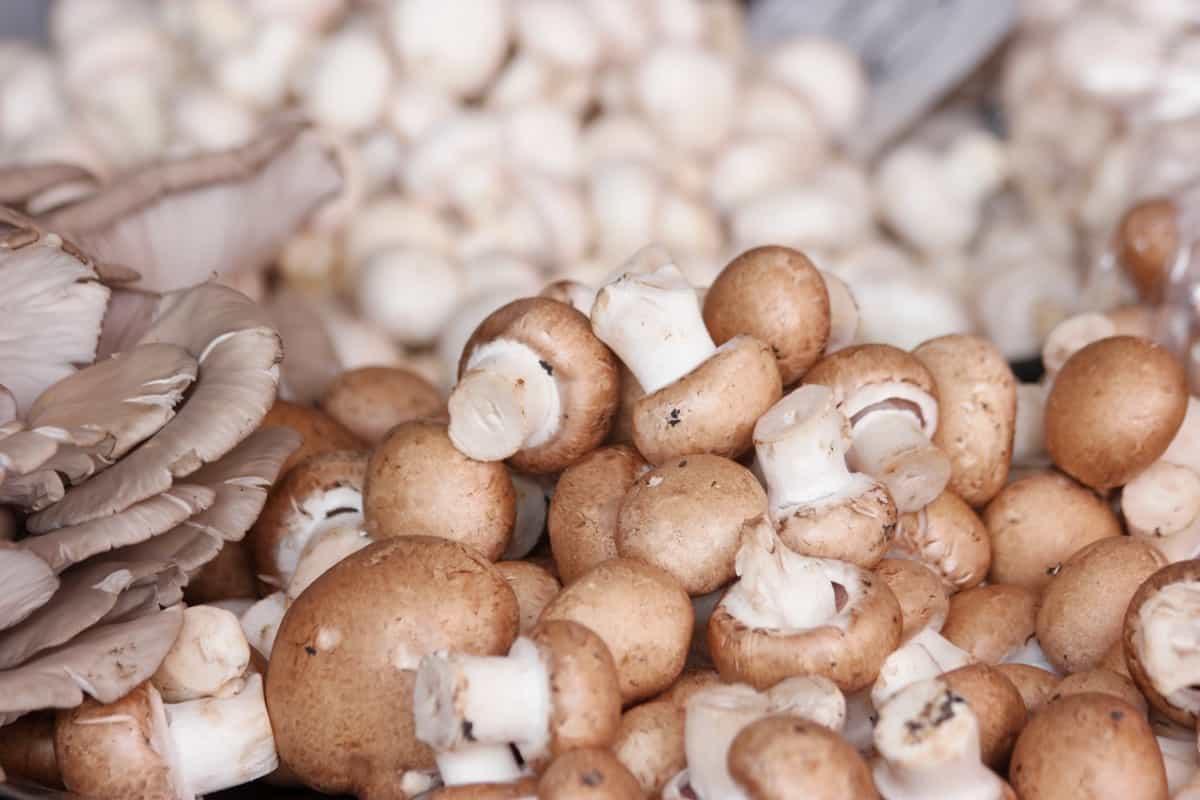
Some farmers even implement innovative techniques like vertical farming or using renewable energy sources to power their operations. These practices not only contribute to sustainability but also promote biodiversity in the ecosystem. Promoting sustainability in mushroom farming is essential for creating a greener future for agriculture.
Mushroom growing can be done on a small scale for personal use or on a large scale for commercial production. It requires careful attention to detail, proper sanitation practices, and knowledge of the specific requirements of the mushroom species being cultivated.
- Economical Aquaculture: A Guide to Low-Budget Fish Farming
- 15 Common Planting Errors That Can Doom Your Fruit Trees
- How to Make Houseplants Bushy: Effective Tips and Ideas
- Innovative Strategies for Boosting Coconut Pollination and Yield
- Pollination Strategies for Maximum Pumpkin Yield
- The Complete Guide to Chicken Fattening: Strategies for Maximum Growth
- Natural Solutions for Tulip Problems: 100% Effective Remedies for Leaf and Bulb-Related Issues
- Revolutionizing Citrus Preservation: Towards a Healthier, Greener Future
- Natural Solutions for Peony Leaf and Flower Problems: 100% Effective Remedies
- Maximizing Profits with Avocado Contract Farming in India: A Comprehensive Guide
- Natural Solutions for Hydrangea Problems: 100% Effective Remedies for Leaf and Flowers
- The Ultimate Guide to Choosing the Perfect Foliage Friend: Bringing Life Indoors
- From Sunlight to Sustainability: 15 Ways to Use Solar Technology in Agriculture
- The Ultimate Guide to Dong Tao Chicken: Exploring from History to Raising
- The Eco-Friendly Makeover: How to Convert Your Unused Swimming Pool into a Fish Pond
- Mastering the Art of Delaware Chicken Farming: Essentials for Healthy Backyard Flocks
- 20 Best Homemade Fertilizers for Money Plant: DIY Recipes and Application Methods
- How to Craft a Comprehensive Free-Range Chicken Farming Business Plan
- Brighten Your Flock: Raising Easter Egger Chickens for Beauty and Bounty
- How to Optimize Your Poultry Egg Farm Business Plan with These Strategies
- Subsidy for Spirulina Cultivation: How Indian Government Schemes Encouraging Spirulina Farmers
- Ultimate Guide to Raising Dominique Chickens: Breeding, Feeding, Egg-Production, and Care
- Mastering the Art of Raising Jersey Giant Chickens: Care, Feeding, and More
- Ultimate Guide to Raising Legbar Chickens: Breeding, Farming Practices, Diet, Egg-Production
- How to Raise Welsummer Chickens: A Comprehensive Guide for Beginners
- How to Protect Indoor Plants in Winter: A Comprehensive Guide
- Ultimate Guide to Grow Bag Gardening: Tips, Tricks, and Planting Ideas for Urban Gardeners
- Guide to Lotus Cultivation: How to Propagate, Plant, Grow, Care, Cost, and Profit
- Agriculture Drone Subsidy Scheme: Government Kisan Subsidy, License, and How to Apply Online
- Ultimate Guide to Raising Araucana Chickens: Breed Profile, Farming Economics, Diet, and Care
- Bringing Hydroponics to Classroom: Importance, Benefits of Learning for School Students
- Ultimate Guide to Raising Polish Chickens: Breed Profile, Farming Economics, Diet, and Care
- Ultimate Guide to Raising Australorp Chickens: Profile, Farming Economics, Egg Production, Diet, and Care
- Silkie Chicken Farming: Raising Practices, Varieties, Egg Production, Diet, and Care
- Sussex Chicken Farming: Raising Practices, Varieties, Egg Production, Diet and Care
- Homemade Feed Formulations for Livestock: Discover Cost-effective Starter to Finisher Feed Recipes
hey hi.
I also want to do farming of mushroom pleases help me.
I intend to enter into mushroom farming on small scale. Can you suggest agencies private or governmental who can guide me into this? I need to know investment required. I have a small farm house where I intend to start this. If you can advise please let me know full details.
Regards,
Vijay
I would like to get training on mushroom cultivation to start my new business in Andhra Pradesh, could you please help me with that.
Mushroom training is provided at Agri Biotech Foundation in Hyderabad.
Can you please give me information about farmers in south india who cultivate mushroooms.
Any one suggest me that where will I get these spawn?
Sir ,I want to start in Surat,Gujarat,so where is mushroom market near me to sell my mushroom
We are based out of south India, you are local vegetable markets are best point of contact for mushroom marketing.
Hello,
We are based in Maharashtra state. can you please give me the whole idea of this mushroom cultivation business. and also help me with other agribiotech training centers.
Hello I am from chhattisgarh. Can you please state where can I find knowledge and training about growing mushrooms.
Thank you
We are going to update a article about mushroom farming training/consulting information.
Hi
I am from Raipur and would like to gain knowledge about the same.The process, the investment and the equipment required for mush room farming.
Thanks
Here is some information about Mushroom Farming Project Report.
I want to set up on a commercial scale in kollata.
Please advice few consultants
You can google it for Mushroom Set Up Consultants. We will be updating a article soon with all training and consultants information.
Hello,
Do you have training facility in Pune Maharashtra.
No, we don’t have any mushroom training facility in Pune. However, we will be updating soon with all training centers for horticulture in India.
Hi, I need to grow mushrooms, please provide the mushroom farming project report.
Go through: Mushroom Farming Project Report.
Hi,
Quick question on Temperature required to cultivate. I have a small land in Chamba (Uttarakhand) at an altitude of 5500ft from sea level; temperature in winter goes up to 0`C and in summers up to 35`C.
With some control, can we set up the facility at this place?
Thanks
You can set up a greenhouse for controlled environment.
You can go through this: Mushroom Farming Project Report.
I am a mushroom farmer but I can’t do anything in summer season….I want to set a ac plant for mushroom growing…. could you tell me how can I do this
Check this: Mushroom Farming Project Report.
hello sir. Iam from madhya pradesh bhopal i want start mashroom farming can you please tell me the where its training happen in bhopal and marketing knowledge about it
I am looking for an expert mushroom plant setting up expert to come to Malawi and set up a business – any leads?
want to start mushrrom cultivation in barmer – rajasthan
need basic training and want to understand other aspects
I am interested in mushroom farming in Jalandhar Punjab.where do I get training in this field.how can as a woman get subsidy for this project.Please guide
I am interested in mashroom farming and I don’t have any agriculture background. Can I do this?
& I am from Bengaluru. Where do I get training
I saw a type of Mushroom Identified as a Narin from India found in a patch of bamboo. Can you tell me a little more about this fungus?